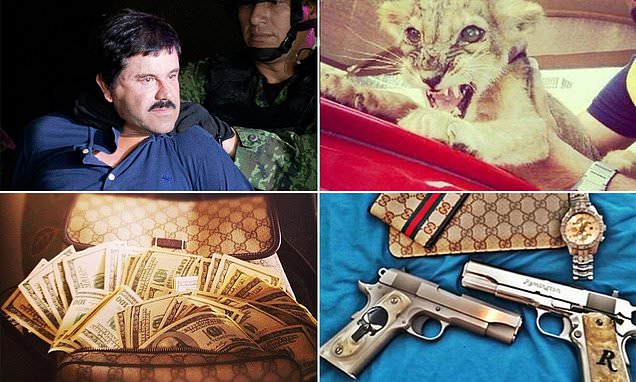
His $10 million beach house sat along the coast in Acapulco. Moored offshore was the Chapito — the yacht he named after himself.
One of his ranches, in rural Guadalajara, Mexico, had tennis courts and pools around the residence. There was even a zoo where guests could board a train to ride among crocodiles and panthers.

In the early 1990s, as Joaquín Guzmán Loera, the Mexican crime lord known as El Chapo, began succeeding as a drug-world entrepreneur, he started making money — tons of it, one of his first employees testified on Tuesday. There was so much cash that Mr. Guzmán used an expensive method to repatriate his profits: He flew the money back from the United States to Mexico in a fleet of private jets.
Testifying for the second day at Mr. Guzmán’s epic drug conspiracy trial, the former employee, Miguel Angel Martínez, turned from telling stories of his boss’s scrappy early years to describing the details of a lavish narco lifestyle. Mr. Martínez was placed on the stand by prosecutors seeking to paint Mr. Guzmán as a kingpin for the ages.
By his account, Mr. Guzmán would on a whim go to Macau to gamble or fly to Switzerland for a rejuvenation cure. He not only gave diamond-studded watches to his workers, but also once paid hundreds of thousands of dollars to commission a folk song about one of his slain friends.

“When I met Mr. Guzmán, he didn’t have a jet,” Mr. Martínez told a spellbound jury in Federal District Court in Brooklyn. “But in the ‘90s, he already had four jets. He had houses at every single beach. He had a ranch in every single state.”
All these spoils and more, Mr. Martínez said, were bought and paid for by the endless streams of illicit cash Mr. Guzmán was earning by shipping tons of cocaine and marijuana to Los Angeles through a wide variety of innovative methods: oil-tanker trains, trucks with secret compartments, cross-border tunnels and cans of jalapeños. Prosecutors say he earned a total of $14 billion in his drug dealing career.
Some of the millions he made were hidden in stashes, one of which sat underneath a bed that could be raised off the floor on a hydraulic-powered lift. Mr. Martínez testified that once a month, he personally wheeled a Samsonite suitcase, stuffed with at least $10 million, into a Mexico City bank to place in Mr. Guzmán’s account.
Such high living slowly took its toll on Mr. Martínez, who said that he began to snort as much as four grams of cocaine a day — often, he admitted, from a gold spoon dipped into a little gold canister. He financed his habit with the $1 million that Mr. Guzmán gave him every year. His addiction was destructive enough that eventually the drugs burned through his septum.

Mr. Guzmán, in contrast, emerged in court on Tuesday as much less of a sybarite. He enjoyed his whiskey, beer and cognac, Mr. Martínez said, and seemed to have a particular fondness for women. But while Mr. Guzmán kept four or five mistresses throughout the 1990s, Mr. Martínez suggested he was not so much in love as he was jealous — often spying on his girlfriends with a wiretap.

Mr. Guzmán was not the only one who reveled in extravagance. Mr. Martínez recounted, for example, how he and his boss once went to visit Juan José Esparragoza, a veteran trafficker who was serving time in prison. When the two men arrived, they discovered their colleague at a jailhouse party, surrounded by waiters, cooks and a mariachi band. Dinner was being served and the guests had a menu to choose from: lobster, steak or pheasant.
But as was often the case in Mr. Guzmán’s orbit, luxury was never far from bloodshed. Mr. Guzmán had paid the visit to the respected older trafficker to ask for his permission to assassinate a rival, Mr. Martínez said.
At that time, Mr. Guzmán and his crew were waging war with the Tijuana drug cartel in a gothic, gruesome conflict. The wife of one of Mr. Guzmán’s allies had already had her throat slit. The ally’s two young children were also victims of the fighting: They had been tossed off a bridge by an assassin.
Mr. Guzmán put the profits from his empire into seeking retribution, Mr. Martínez said, outfitting an army of gunmen and setting off a two-year cycle of attacks. One took place in 1992 at a Puerto Vallarta nightclub. The following year, a revenge attack for the nightclub shooting claimed the life of Juan Jesús Posadas Ocampo, a beloved Roman Catholic cardinal.
In his testimony Tuesday, Mr. Martínez offered a startling account of the cardinal’s death, saying that his killers had slain him accidentally while gunning for Mr. Guzmán. The hit took place in the middle of the Guadalajara airport, he recalled. Mr. Guzmán escaped the hail of bullets by fleeing past a baggage carousel and out onto the street — all while toting a suitcase filled with $600,000 in cash.
Despite these grisly stories, Mr. Martínez claimed in court that he was not a violent man. In fact, he said, the only time he ever owned a gun, Mr. Guzmán told him to get rid of it. The kingpin was worried he might hurt himself.
But once, he said, he asked his boss why he was so enamored of hostility.
“I said to him, ‘Why kill people?’” Mr. Martínez told the jury. “And he answered me: ‘Either your mom’s going to cry or their mom’s going to cry.’”
